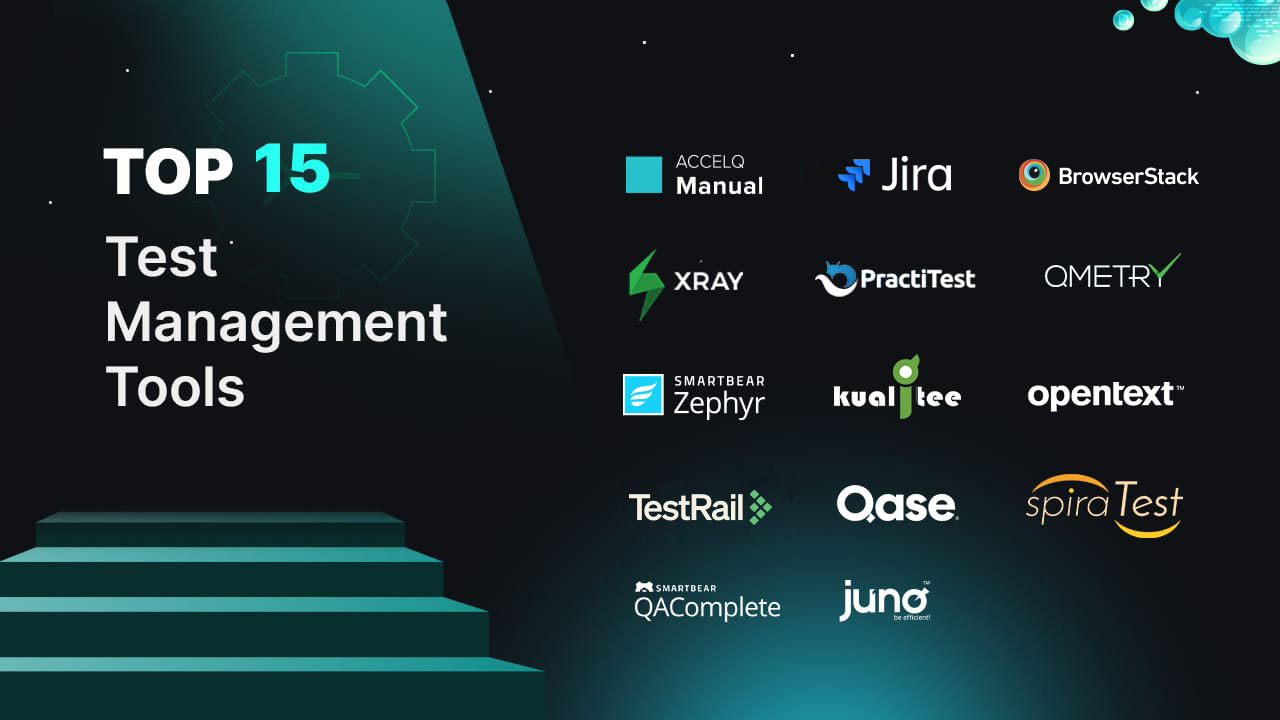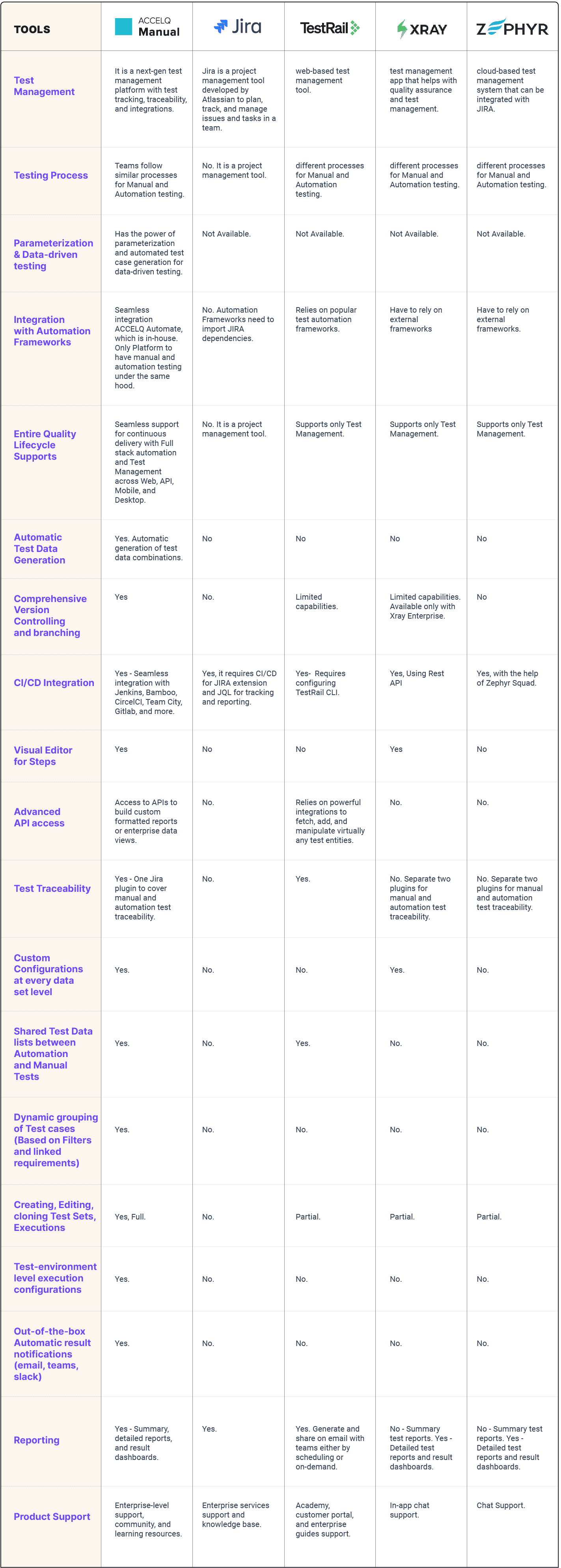TOP 15 Test Management Tools In 2025

A test management tool streamlines software testing activities, encompassing planning, design, execution, and monitoring of tests. The tools for test management ensure comprehensive coverage of all test scenarios, simplifying the testing process. These tools provide a combined platform to organize and manage requirements, defects, test cases, and test scenarios.
What is the purpose of a test management tool?
“According to market research future, the test management software market is predicted to expand from USD 1.13354 billion to USD 3.92 billion by 2032.”
The purpose of a test management tool for software testing is to enable efficient software testing and delivery on time without compromising quality. Let’s further read a few reasons why you require a test management tool:
- Helps your teams to plan, design, and execute tests systematically.
- Improves communication and coordination among your team members.
- Ensures complete traceability between requirements, tests, and defects.
- Offers detailed insights into testing progress and quality metrics.
- Enable your team to automate many testing processes, reducing manual effort and increasing productivity.
- Ensures that all test scenarios are covered and all requirements are met to reduce defects and deliver good software.
15 Popular Test Management Tools
1. ACCELQ Manual

ACCELQ Manual is a next-gen test management platform for Agile teams. This platform provides features such as test tracking, traceability, integrations, and more. It is a unified test management platform that brings various types of testing together and seamlessly integrates with Jira and Jenkins.
Features:
- ACCELQ manages test creation and execution in parallel.
- API test case management, planning, execution, and tracking governance are supported.
- Built-in asset sharing and version control capabilities.
- Test runs are organized by this test automation platform at the test and suite levels.
- Inline screenshots are provided during test execution.
- A video-style slide show is recorded for the execution results.
“ACCELQ offers a modern and intuitive test design and management. This no-code automation platform runs, and records test results at the step level for batch executions with Q-Runner for smooth and fast test execution. ACCELQ offers dynamic reporting with perspectives to slice and dice reports easily.”
2. JIRA

Jira is a project management tool. It offers agile planning, customizable boards, and workflows for estimation and reporting.
Features:
- Make projects easy to manage with Scrum and Kanban boards.
- It uses a timeline view to sync teamwork and manage dependencies.
- Jira, Jenkins, and Github integrations are supported.
Pros & Cons of Jira
- Project management
- Task tracking
- Customizable workflows
- Not beginner-friendly
- Poor user experience
- Complex workflow configuration
3. BrowserStack Test Management
BrowserStack Test Management is an AI-powered test management tool that streamlines the creation, execution, and management of automated and manual test cases with intuitive workflows. This full-stack test management tool also offers insights through a customisable dashboard. It was recently recognized as #1 in Test Management G2 Grid® Report.
Features:
- Offers AI agents to generate test cases from PRDs and user stories, auto-fill steps and preconditions, and convert them into low-code automated tests.
- Supports test frameworks like Selenium, Playwright, etc. and CI/CD tools such as Jenkins, CircleCI and more.
- With two-way Jira binding, all test cases and test runs are visible and manageable in both BrowserStack Test Management and the Jira app.
- Offers extensive documentation and 24/7 support via email, chat & phone.
Pros & Cons of BrowserStack Test Management
- Intuitive interface with barely any learning curve
- Improves traceability by linking requirements, test cases & defects.
- Rich analytics dashboard with real-time insights
- Offers a free plan
- Free plan is limited to 5 users
4. TestRail

TestRail is a web-based test management tool. The web interface of this tool can design, organize, execute, and track tests.
Features:
- This tool automates the upload of test results from GitLab and Bitbucket.
- Tracks testing progress and makes reports.
- Links defects to Jira for reporting to the development team.
Pros & Cons of TestRail
- Milestone modules to manage releases
- Jira integrations
- Reusable test cases
- Jira integration is limited; issues aren’t manageable
- Restricts reporting capabilities
- No requirements and issues modules
5. XRay

XRay is a Jira test management app. It streamlines testing for deployment readiness. This app makes teamwork faster and easier.
Features:
- Integration with CI/CD tools.
- Requirements coverage.
Pros & Cons of XRay
- Detailed test case management
- Test execution and logging
- Jira integration
- Integration issues
- Generating reports requires external tools
- Performance is compromised due to Jira storage
6. PractiTest

PractiTest is a tool for test data management in software testing. It can bring the entire QA team, process, and tools into a single platform.
Features:
- QA artifacts are managed in a single location for comprehensive coverage and traceability.
- Reports on previous tests daily, weekly, or monthly.
- Various tools integration is supported.
Pros & Cons of PraciTest
- Easy-to-use graphical user interface
- Can create custom fields on test cases
- Customized reports
- Needs better dashboard display
- Difficult integration of tools into platforms
- Filters and fields need to be added
7. QMetry

QMetry is an agile test case management software. Agile teams can build, manage, and deploy software with this tool.
Features:
- Version Control can create and keep versions of your test assets.
- Chart reports with custom dashboards.
- DevOps with continuous testing, Git, and more is accelerated.
Pros & Cons of QMetry
- Integrates with test automation tools
- Built-in requirement and issue module
- Graphical project reports
- Test case steps fail to load; manual linking is needed during test runs
- No integration with agile management tools
- Moving test cases across projects is challenging
8. Zephyr

Zephyr Enterprise test management tool is managed outside the Atlassian ecosystem. This standalone tool integrates with Jira in real-time.
Features:
- This tool provides a global test repository for teams and projects.
- Tracks progress and logs defects in Jira while executing tests.
- Tracks progress and collaborates with your team on Jira.
Pros & Cons of Zephyr
- Supports automation frameworks
- Jira integration
- Cross-project reports
- Slow page loading
- Steep learning curve
- Some degree of vendor lock-in is required
9. Kualitee

Kualitee simplifies test case management and automates testing. Pre-written tests can be brought by testers from the Test Case Library.
Features:
- Test software by creating and managing it for different parts.
- Customize fields to work seamlessly with integrated data sources.
- This tool supports the manual execution of tests.
Pros & Cons of Kualitee
- Test cases
- Bulk test edits are supported
- Dashboards
- No AI-powered functionalities
- Limited reports
- Difficult learning curve
10. OpenText ALM Quality Center

OpenText ALM Quality Center is a software test case management tool that provides tracking and reporting capabilities. This tool manages applications and helps teams prevent critical functions from being missed.
Features:
- Uses requirement and test coverage analysis to check that requirements are met.
- Live analysis graphs and reports are offered.
- This tool utilizes open-source technologies and various application lifecycle management tools for seamless integration.
Pros & Cons of OpenText ALM Quality Center
- Test planning
- Test execution
- Reporting
- Too complex for small projects and teams
- User difficulty
- Expensive
11. Qase

Qase is QA testing software that orchestrates manual and automated testing. It can be connected to issue trackers that are frequently used.
Features:
- Smart Wizard of this software creates test plans and checks each test case in one go.
- Dashboards display results visually.
- Integrates with CI/CD tools to facilitate testing and collaboration with the team.
Pros & Cons of Qase
- Test case review
- Integrations are available
- Reports
- Limited customization
- Integration issues
- Limited reusability of test steps between test cases
12. SpiraTest

SpiraTest manages bugs and issues during testing in one place. This tool tracks all software testing steps.
Features:
- User-friendly wizard grades tests and detects defects.
- This tool connects with other tools to track work progress.
- Printable reports and charts.
Pros & Cons of SpiraTest
- All test cases are saved in one location
- Requirements management
- Can recall test results anytime
- User difficulty
- Login issues
- Expensive
13. RTM
Requirements and Test Management for Jira is an app. RTM streamlines software development in the Atlassian suite.
Features:
- Built-in requirements management.
- Organize tests in a tree to manage them easily.
- Monitor project progress with an execution report. This app has reusable test plan templates.
Pros & Cons of RTM
- Centralized test management
- Test case executions
- Documentation
- Complex setup
- Limited reporting
- Steep learning curve
14. QAComplete

QAComplete is a software test management tool that manages tests and defects using user stories. It organizes tests and tracks requirements to deliver software.
Features:
- The test library screen allows you to create, edit, and organize tests.
- Test sets are used to organize tests in groups and execute them in the specified sequence.
- This tool offers report templates for customized reporting.
Pros & Cons of QAComplete
- Test data management
- Integrates with automation tools
- Dashboards
- Outdated user interface
- Limited workflow customization
- Performance issues
15. JunoOne

JunoOne manages tests and issues with JIRA integration. This tool simplifies test management.
Features:
- This tool filters and reports selected test executions.
- Sort test cases and create PDF or XLS reports.
- GitLab and JunoOne can execute projects simultaneously.
Pros & Cons of JunoOne
- Streamlined workflows
- Task management
- Customizable dashboards
- Test filtering issues
- Lacks reporting for diverse project views
- Price is slightly expensive
Trends related to test management tools
- The rise of cloud-based test management tools is not only driven by scalability and accessibility, but also by their flexibility and cost-effectiveness.
- Integration of AI and machine learning technologies automates tests and generates test cases.
- Tools featuring report dashboards and live analytics display the progress of your testing efforts.
- These tools enhance security testing capabilities and ensure compliance with various standards in high-risk industries, including finance and healthcare.
- A balance between simple and rich features in the user interface design ensures all your team members can use it regardless of their technical skills.
- Test management tools are gaining popularity. Contributing communities are also growing and evolving along with their development.
Conclusion
ACCELQ is the best tool/platform with its next-gen manual test designer, execution engine, test management, and more. Test management on this platform is AI-based, providing a holistic view of QA progress. ACCELQ offers automated migration from traditional test management tools. It is the only platform that combines manual and automation testing under the same roof.
Book a free trial to explore how the ACCELQ Manual, an all-new next-gen test management tool, helps you take action and make decisions to automate your tests.
You Might Also Like:
 How to Ease QA Teams Into Automation?
How to Ease QA Teams Into Automation?
How to Ease QA Teams Into Automation?
 Test Automation Framework: Definition, Types, Pros, and Cons
Test Automation Framework: Definition, Types, Pros, and Cons
Test Automation Framework: Definition, Types, Pros, and Cons
 Self-Healing Test Automation: A Comprehensive Guide
Self-Healing Test Automation: A Comprehensive Guide
































